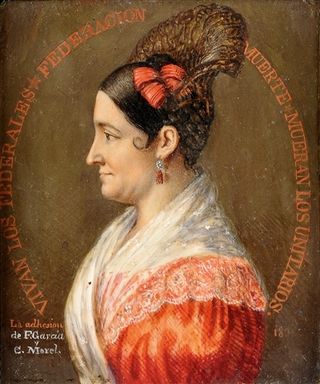 This stately Di Sarli vals sung by Alberto Podestá tells a rather grim story. Explanatory notes follow the English version. Full text in Spanish and English and explanatory notes follow the video.
This stately Di Sarli vals sung by Alberto Podestá tells a rather grim story. Explanatory notes follow the English version. Full text in Spanish and English and explanatory notes follow the video.
Estampa federal*
("Federalist Sketch")
Waltz
Music: Pedro Maffia / Sebastián Piana
Lyric: Cátulo Castillo
|
Se enredan en la noche Ríe entre las sombras |
Your deep, black pupils Doña Encarnación* |
Notes
* Estampa Federal: This historical "sketch" or "impression" (estampa) refers to the struggle between the federales, who advocated a loose confederation of states without centralized leadership, and the unitarios, who advocated a unified Argentina with Buenos Aires as its center. The country was led for nearly twenty years by federale chief General Juan Manuel de Rosas, who ruled the country with an iron fist. Rosas demanded fierce, demonstrative loyalty from every citizen, and conducted a reign of terror to intimidate and in many cases exterminate the opposition.
*lilac: Blood red was the omnipresent symbol of the Rosas regime. Citizens were compelled to wear certain articles of red clothing at all times–waistcoats and hatbands for men, for example. Wearing blue, the color of the unitarios, was not only forbidden, but punishable by death. Lilac is purple in color, that is, a mixture of red and blue. The image of lips tinged with lilac suggests conflicting sympathies.
*flight: Many unitario families were dispossessed and forced into exile in Brazil or Uruguay. In the first verse, two lovers plan to flee the repressive regime together, but the girl changes her mind at the last minute ("I receive your farewell"). In the second verse, they both rejoin rosista society, as reflected in their attendance at the red-draped fiesta of the mazorqueros, and the narrator bitterly watches his beloved, her hair decorated with red ribbons, dancing gavottes and lanceros with the paramilitary officers.
*Doña Encarnación: Doña Encarnación Ezcurra (portrait, above, right) was the wife of General Rosas and also the brains behind the Mazorca, a paramilitary death squad that conducted the reign of terror during her husband's regime. Note the slogans inscribed on the portrait: "Long Live the Federales. Federation or Death. Death to the Unitarios."
*federalist ribbons in your peinetón: The peinetón was an outsized decorative comb that upper-class ladies of the rosista period wore in their hair. They also wore compulsory red hair-ribbons (moños federales) to demonstrate allegiance to the federalist cause. In the portrait above, Doña Encarnación sets the style for the women of nation.
*mazorqueros: Members of the Mazorca.
*gavottes, lanceros: Popular dances of the era.
*red-draped fiesta: The original text merely says "fiesta roja," literally, a red party, but Rosas required that the venue of any official function be decorated with gobs of red bunting. The mazorqueros would certainly have observed this rule, and the image also underscores the blood-thirsty character of their actions.

Very interesting Michael. Di Sarli seems to be a real patriot; he it is who tells us about a mazorquero fiesta in the milonga “La mulateada”.
LikeLike